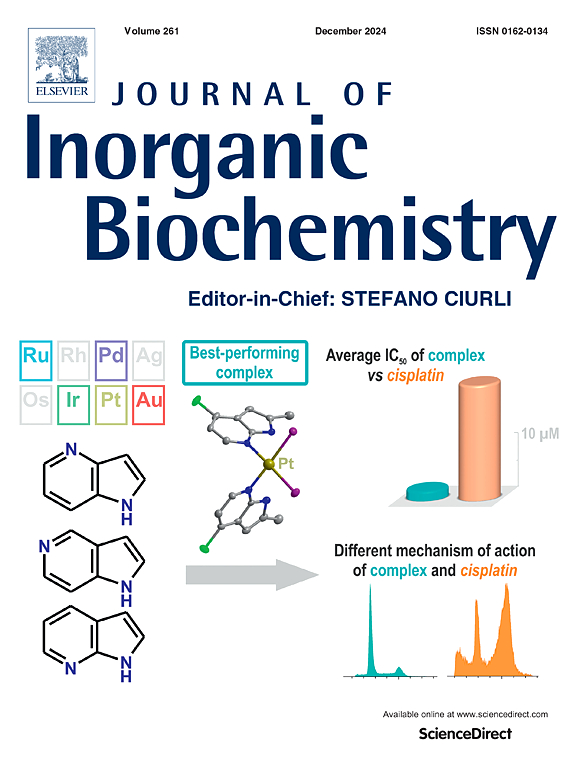铱(III)配合物作为I型光敏剂用于缺氧双光子光动力治疗
IF 3.2
2区 化学
Q2 BIOCHEMISTRY & MOLECULAR BIOLOGY
引用次数: 0
摘要
光动力疗法(PDT)是一种非侵入性的治疗方式,近年来显著改善了皮肤癌的治疗。尽管如此,传统光敏剂的局限性,如对氧气的依赖和受限的光穿透,仍然对临床应用构成相当大的挑战。本文中,五种铱(III)配合物被开发为I型光敏剂,用于双光子PDT靶向黑色素瘤。这些复合物在缺氧条件下表现出显著的双光子吸收(TPA)截面(σ2≥100 GM)和高的活性氧(ROS)产率,在低剂量单光子或双光子激发下产生ROS导致线粒体损伤和随后的凋亡。值得注意的是,Ir4@PEG在缺氧条件下的IC50值为2.1 μM,光毒性指数(PI)为47。细胞实验表明Ir4@PEG最初靶向并定位于溶酶体内,在那里溶酶体膜随后在光刺激下受损,导致Ir4转移并破坏线粒体,导致细胞凋亡。此外,Ir4@PEG在缺氧的三维肿瘤球体中显示了肿瘤穿透性的改善、ROS的显著产生和明显的光毒性。这些发现为设计氧不依赖、金属基双光子光动力治疗缺氧黑色素瘤提供了新的见解。本文章由计算机程序翻译,如有差异,请以英文原文为准。

Iridium(III) complexes as type I photosensitizers for hypoxic two-photon photodynamic therapy
Photodynamic therapy (PDT), a non-invasive therapeutic modality, has significantly improved skin cancer treatment in recent years. Nonetheless, the limitations associated with conventional photosensitizers, such as their substantial dependence on oxygen and restricted light penetration, continue to pose considerable challenges for clinical applications. Herein, five Iridium(III) complexes have been developed as type I photosensitizers for two-photon PDT targeting melanoma. These complexes exhibit notable two-photon absorption (TPA) cross-sections (σ2 ≥ 100 GM) and high yields of reactive oxygen species (ROS) under hypoxic conditions, leading to mitochondrial damage and subsequent apoptosis through ROS generation with low doses of single or two-photon excitation. Notably, Ir4@PEG exhibits an IC50 value of 2.1 μM and a phototoxicity index (PI) of 47 under hypoxic conditions. Cellular assays indicate that Ir4@PEG initially targets and localizes within lysosomes, where the lysosomal membrane is subsequently compromised upon light stimulation, resulting in Ir4 transferring and damaging mitochondria, causing cell apoptosis. Additionally, Ir4@PEG demonstrates improved tumor penetration, significant ROS production, and marked phototoxicity in hypoxic three-dimensional tumor spheroids. These findings provide new insights into designing oxygen-independent, metal-based two-photon photodynamic therapies against hypoxic melanoma.
求助全文
通过发布文献求助,成功后即可免费获取论文全文。
去求助
来源期刊

Journal of Inorganic Biochemistry
生物-生化与分子生物学
CiteScore
7.00
自引率
10.30%
发文量
336
审稿时长
41 days
期刊介绍:
The Journal of Inorganic Biochemistry is an established international forum for research in all aspects of Biological Inorganic Chemistry. Original papers of a high scientific level are published in the form of Articles (full length papers), Short Communications, Focused Reviews and Bioinorganic Methods. Topics include: the chemistry, structure and function of metalloenzymes; the interaction of inorganic ions and molecules with proteins and nucleic acids; the synthesis and properties of coordination complexes of biological interest including both structural and functional model systems; the function of metal- containing systems in the regulation of gene expression; the role of metals in medicine; the application of spectroscopic methods to determine the structure of metallobiomolecules; the preparation and characterization of metal-based biomaterials; and related systems. The emphasis of the Journal is on the structure and mechanism of action of metallobiomolecules.
 求助内容:
求助内容: 应助结果提醒方式:
应助结果提醒方式:


